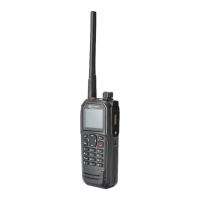DP770 Service Manual
The frequency generation circuit is composed of VCO and PLL. It is the core module of the whole TX-RX
system. This circuit provides accurate carrier frequency during transmission; and provides stable local
oscillator signal during reception. It has a direct influence on the performance of the system.
• Working Principle of PLL
The 12.8MHz frequency generated by the reference crystal oscillator goes to PLL for division, generating
the reference frequency (i.e step frequency f1). The frequency generated by VCO is filtered harmonic via
LPF and generates another frequency (f2) through the frequency divider in PLL. Then frequencies f1 and f2
are compared in the phase detector (PD), to generate continuous pulse current. The pulse current goes to
the loop filter for RC integration and is then converted to CV voltage. Then the CV voltage is sent to the
varactor of VCO. It adjusts the output frequency of VCO directly until the CV voltage becomes constant.
Then the PLL is locked, and the stable frequency output by VCO goes to the TX-RX channel after passing
through two buffer amplifiers.
• Working principle of VCO
Voltage controlled oscillator applies oscillation mode of three-point capacitance, and gains different output
frequency through changing controlled voltage (CV) of varactor. Rx VCO is composed of oscillating circuit
and Q24/Q29 and provides local oscillation signal. Tx VCO is composed of oscillating circuit and Q27/Q28
and provides carrier of Tx signal.
Working principle employs colpitts oscillator circuit (the RX oscillator circuit is composed of D102, D103,
D106, D107 and L112 (VHF:D32, D33, D36, D34 and L23); the TX oscillator circuit is composed of D108,
D109, D110, D101and L117 (VHF:D38, D39, D40, D41 and L31). It obtains different output frequencies by
changing control voltage of varactor (i.e.CV voltage).RX VCO is composed of oscillator loop and Q104
(VHF:Q43), providing local oscillator signal. TX VCO is composed of oscillator loop and Q108 (VHF Q44)
and provides carrier of TX signal.
• Two-point Modulation
To obtain higher modulation accuracy and lower 4FSK bit error, it employs two-point modulation technology
in the TX mode. MOD1 and MOD2 send the modulation signal to the modulation end of VCO and the
reference crystal oscillator of PLL respectively to modulate TX VCO and the reference crystal oscillator.
3.1.4. GPS Circuit
Figure 3-6 GPS Circuit Diagram
The GPS function is realized via REB-1315LPx (GPS module).The GPS module integrates a baseband
processor, a LAN and a SAW. The GPS function is realized via the following steps:
Page 10 of 102

